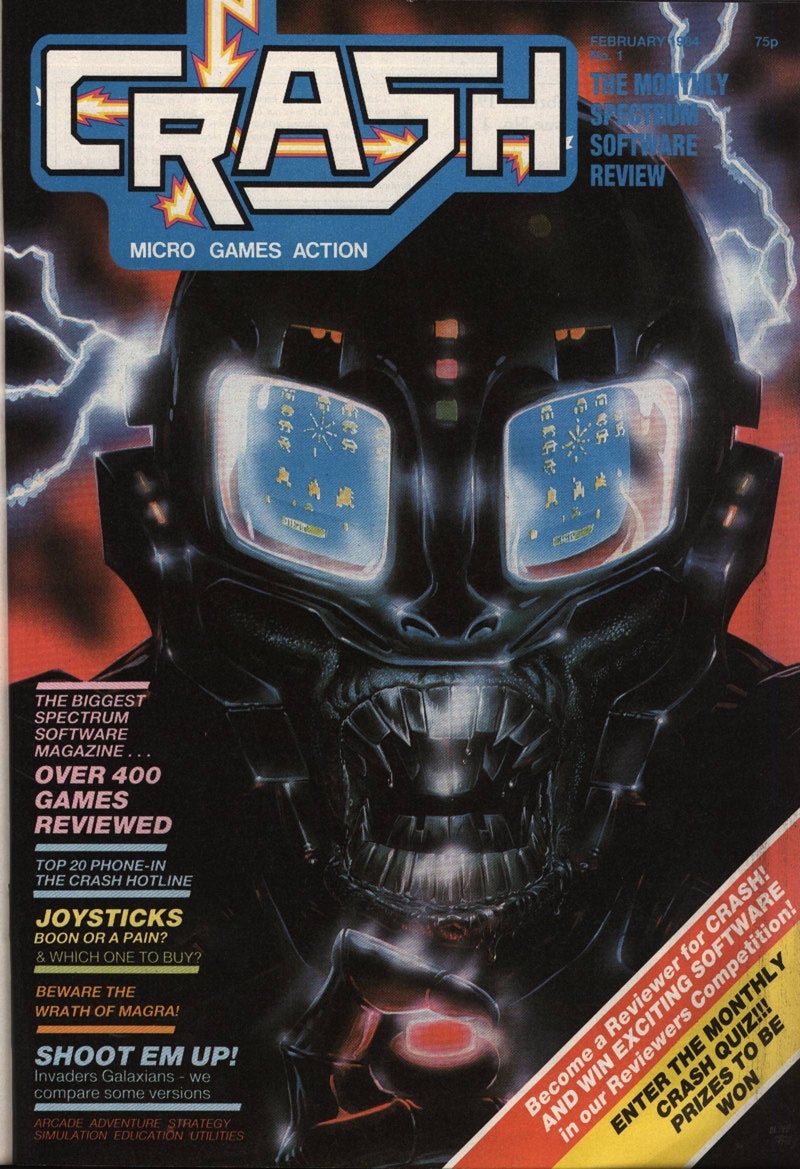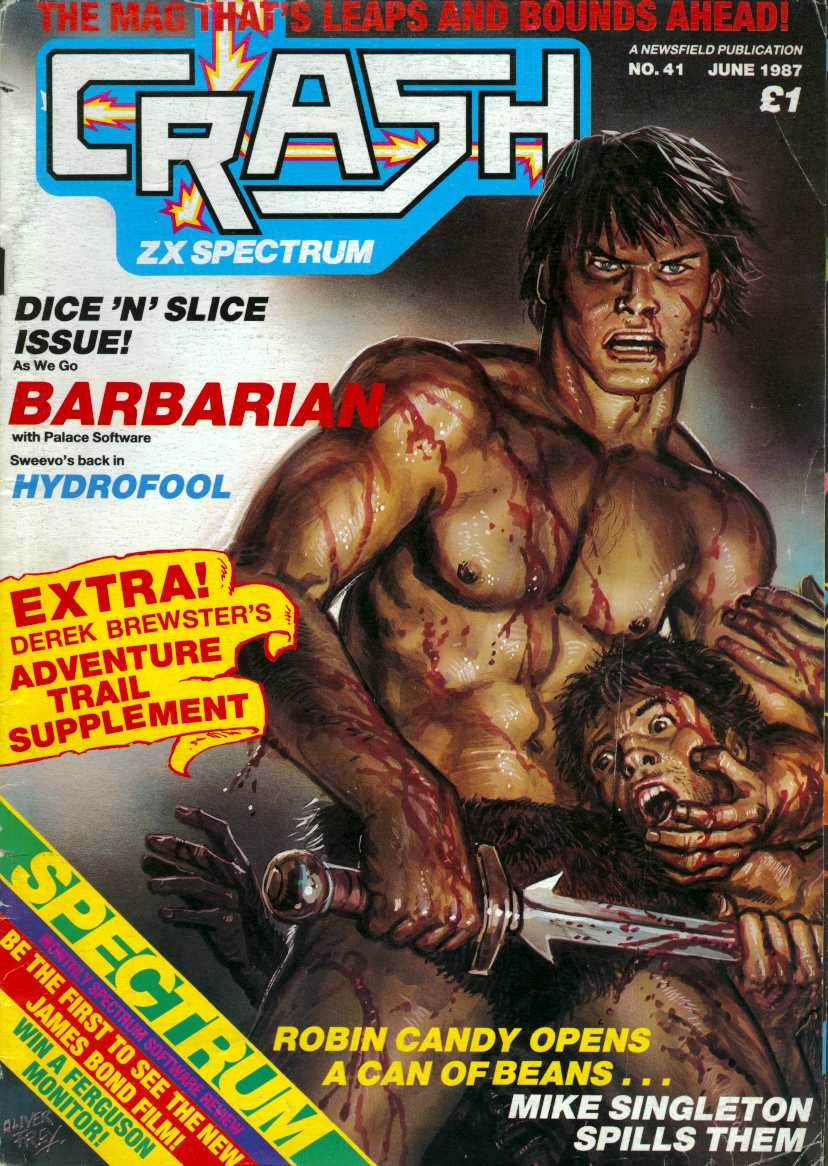Frey was one of the founders of Newsfield, the publisher largely responsible for the explosion of gaming magazines in the early 1980s. The company started out publishing a mail order ZX Spectrum games catalogue which quickly evolved into a newsstand magazine called Crash. Other seminal titles, such as Commodore mag Zzap!64 and the Amstrad specific Amtix, soon followed. This was an era when players had virtually no access to information about new games prior to release. No internet rumours, no social media leaks. If it wasn’t covered in a magazine, it might as well not exist. Even when a game was covered in their pages there was a good chance it would involve little more than a handful of black and white screenshots. Often, these were literally photographs of the screen, reproduced on grainy paper. Working out what a game actually looked like was a dark art. This was also a time before press kits and media assets homogenised that information. If a magazine wants to put a game on their cover today, they have an array of slick approved imagery to choose from, all easily downloadable from the publisher’s PR department. In the 80s, cover artwork was created bespoke, with illustrators tasked with turning these abstract pixel screens into eye-catching art, and nobody was more prolific or adaptable as Frey. Between 1983 and 1991, Newsfield put out hundreds of magazines and, with few exceptions, Oliver Frey’s rich, detailed airbrushed art graced the cover of every single one. Born in Switzerland in 1948, Frey spent time in the UK as a child and returned here as a young man in the 1970s to study at the London Film School and work as a freelance illustrator. One of his most notable jobs during this period was being picked by director Richard Donner to create the comic book seen in the opening sequence of his 1978 Superman movie. Frey also illustrated strips for the Planet of the Apes, contributed to the influential Trigan Empire comic series in Look & Learn magazine and drew Dan Dare for the rebooted Eagle in the early 80s. At the same time as he was undertaking this mainstream work, Frey was also working under the pseudonym Zack, producing gay erotica for magazines that he published with his lifelong partner Roger Kean. Russell T. Davies is on the record crediting Frey’s unashamedly sexy and romantic slice-of-life comic strips as a major influence on his award-winning Queer as Folk. It’s gaming where Frey truly made his name though. His vibrant, confrontational covers were the first thing hundreds of thousands of readers saw when they picked up their favourite magazines each month. Sometimes they were Frey interpretations of big multimedia franchises, tying in with some blockbuster game. James Bond, Batman, RoboCop, Jason Voorhees…he drew them all, and made them his own. But when no big name title was available, his covers could also be startlingly original and abstract. One famous 1987 Crash cover depicted Fred Astaire and Ginger Rogers dancing on a keyboard. Another had a surfer riding on a Spectrum through a pastel blue wave. For Christmas 1985, he had Santa Claus giving a copy of Space Invaders to a gigantic green alien monster. Joysticks were transformed into towering sci-fi citadels, ghoulish phantoms beamed adventure game parser from their glowing eyes. His covers also flirted with controversy, as games became more bloodthirsty and gaming mags followed suit. In 1985 adventure game Dun Darach inspired a bondage-themed cover featuring a scantily clad sorceress dominating a muscular young man in chains. Frey’s cover for Palace Software’s Conan-esque fighting game Barbarian featured a nearly naked young warrior, smeared in blood, calmly stabbing his prone opponent in the chest. Newsagents complained, readers were thrilled. Of course, time marched on, magazine budgets plummeted as the last echoes of the 8-bit boom faded away, and bland stock photos began to replace Frey’s creations on issues that dwindled in page count. Newsfield tried launching several new ventures, including horror magazine FEAR and multi-format console mag The Games Machine, but the company was never able to recapture its 80s heyday. The magazine brands were sold to Europress in 1991, and limped on for a few more issues, but without Frey’s distinctive aesthetic to tie them together, it was only a matter of time before they sputtered out. But the impact of his art remained. His distinctive style, equal parts cartoon energy and airbrushed painting, was burned into the memories of every gamer who ever dashed to the newsagent looking for the new Crash or Zzap. Although he never worked on a single game himself, his artwork was the default vision for how all the biggest computer games looked to an entire generation. Since first hearing the news of his passing, I’ve been trying to think of a comparable talent – someone else who produced so much in a single field, so consistently, so influentially. Marvel Comics legend Jack Kirby is one comparison. He too produced a frankly mind-boggling volume of work in a relatively short period, and never showed a dip in quality or imagination. Drew Struzan is another, the famous movie poster artist whose painstakingly photoreal depictions of Luke Skywalker, Indiana Jones and others was the default aesthetic of the 1980s Hollywood blockbuster. Both had signature styles, instantly recognisable, that defined their genres. It’s a testament to Frey’s commitment and talent that such comparisons even make sense. But he wasn’t some distant media titan, he was one of our own, someone who saw not only the business potential in British gaming from the very start, but was endlessly, exuberantly inspired by the community and medium, and poured that passion into his work. In recent years, with interest in retro gaming rising, both Frey and Kean had rekindled their 8-bit connection and reconnected with their fanbase. Crash was relaunched by Fusion Retro Books, first as a nostalgic hardback annual, then as an ongoing retro-themed newsstand title once again. Frey was involved and produced new art, while also selling prints and canvases of his iconic early covers to fans. If there’s solace in this week’s sad news, it’s knowing that this remarkable artist could finally see just how much his work meant to us.

